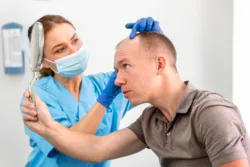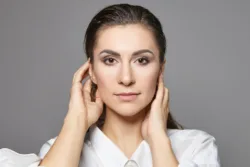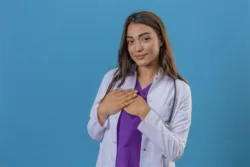Introduction:
Blepharoplasty surgery, also known as eyelid surgery, has become increasingly popular for both functional and cosmetic reason, but some blepharoplasty myths still surround the procedure. Thousands of individuals choose this surgical improvement each year, whether it is to increase peripheral vision, reduce wrinkles, or minimize swelling. But despite its wide popularity, blepharoplasty is frequently covered in misconceptions and myths that interfere with patients from making good decisions.
In this blog, we will discuss the common blepharoplasty myths so that you can get the correct information.
Blepharoplasty Myth: 1. It’s only a cosmetic procedure
Blepharoplasty is commonly done for medical purposes, but it is also commonly done for aesthetic purposes, like making a person look younger or more alert. For example, extra skin on the upper eyelids may droop over the eyelashes, causing peripheral blurry vision. In some situations, surgery on the upper eyelids is medically required and may be covered by insurance.
The benefit of functional blepharoplasty:
Enhance eyesight blocked by droopy eyelids, reduce strain or eye fatigue, and handle symptoms such as dermatochalasis.
Blepharoplasty Myth: 2. It’s only for older people
Blepharoplasty is not only dependent on age. In addition to the flexibility and puffiness that come with age, younger people may also have genetic conditions like:
– Puffy lower eyelids, sometimes known as “bags” beneath the eyes
– Eyes with hoods
– Asymmetry in the structure of the eyelids
Lower lid surgery can be done on people in their 20s and 30s to remove fatty deposits or treat genetic puffiness for a more youthful appearance.
Blepharoplasty Myth: 3. Visible Scars After Eyelid Surgery
Visible scarring is one of the biggest concerns for patients. In reality, blepharoplasty is a precise procedure. It involves making incisions along the natural wrinkles of the eyelids. These scars become almost invisible after healing.
Furthermore, experienced surgeons may do transconjunctival blepharoplasty (for the lower lids), which removes the need for any exterior incisions, and use advanced stitching procedures.
Blepharoplasty Myth: 4. Chronic dry eye is a common side effect
This is not true. As the eyelids recover, some patients may have temporary dry eye symptoms like irritation or a grainy sensation, but these problems normally go away. Dry eye occurs when the eyelids don’t close all the way when you blink, which can happen in the early stages of recovery. But this usually disappears quickly, and moisturizing eye drops or creams might help. Selecting a qualified surgeon who is aware of the delicate architecture of the eyelids can help prevent chronic dry eye, which is uncommon and frequently preventable.
Blepharoplasty Myth: 5. It can get rid of all eye wrinkles
Blepharoplasty mainly targets the fat and sagging skin around the eyelids, not crow’s feet or fine lines.
Although the procedure may slightly smooth the skin, it doesn’t eliminate wrinkles caused by aging or muscle activity.
To achieve full improvement, many patients add wrinkle treatments like Botox, fillers, or laser therapy.
Surgeons often combine these treatments with blepharoplasty to create a more complete rejuvenation of the eyes.
Conclusion:
Blepharoplasty is a very successful treatment that can enhance life quality and rejuvenate the eyes. Don’t allow misconceptions and incorrect data to prevent you from considering your options. To obtain individualized guidance and clarification, make an appointment for a consultation with a qualified plastic surgeon if you’re thinking about having eyelid surgery, please visit at please visit at Aestheticure. Our best expertise and experienced surgeons will provide you with the best treatment and proper care.
For more information or to schedule a consultation, feel free to Contact Us!







